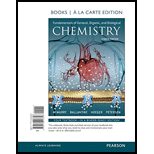
(a)
Interpretation:
It should be identified that whether the given reaction is balanced or not. If it is an unbalanced equation the equation should be balanced.
Concept introduction:
In a balanced equation the number of atoms of each element as a reactant is equal to the number of atoms of that element as a product.
Coefficient is a number placed before a formula in a chemical equation.
A balanced equation should be obeying the law of conservation of mass. Law of conservation of mass states that, the number of atoms remains constant throughout the reaction, simply it can be stated as follows, “during a
(b)
Interpretation:
It should be identified that whether the given reaction is balanced or not. If it is an unbalanced equation the equation should be balanced.
Concept introduction:
In a balanced equation the number of atoms of each element as a reactant is equal to the number of atoms of that element as a product.
Coefficient is a number placed before a formula in a chemical equation.
A balanced equation should be obeying the law of conservation of mass. Law of conservation of mass states that, the number of atoms remains constant throughout the reaction, simply it can be stated as follows, “during a chemical reaction atoms are neither be created nor be destroyed”.
(c)
Interpretation:
It should be identified that whether the given reaction is balanced or not. If it is an unbalanced equation the equation should be balanced.
Concept introduction:
In a balanced equation the number of atoms of each element as a reactant is equal to the number of atoms of that element as a product.
Coefficient is a number placed before a formula in a chemical equation.
A balanced equation should be obeying the law of conservation of mass. Law of conservation of mass states that, the number of atoms remains constant throughout the reaction, simply it can be stated as follows, “during a chemical reaction atoms are neither be created nor be destroyed”.
(d)
Interpretation:
It should be identified that whether the given reaction is balanced or not. If it is an unbalanced equation the equation should be balanced.
Concept introduction:
In a balanced equation the number of atoms of each element as a reactant is equal to the number of atoms of that element as a product.
Coefficient is a number placed before a formula in a chemical equation.
A balanced equation should be obeying the law of conservation of mass. Law of conservation of mass states that, the number of atoms remains constant throughout the reaction, simply it can be stated as follows, “during a chemical reaction atoms are neither be created nor be destroyed”.
Want to see the full answer?
Check out a sample textbook solution
Chapter 5 Solutions
Fundamentals of General, Organic, and Biological Chemistry, Books a la Carte Edition (8th Edition)
- What is the empirical formula for C3H6O3? C3H6O3 C6H12O6 CH2O None of thesearrow_forwardThe reaction CO (g) + H2O(g) CO2(g) 2 + H2(g) has ΔH = -41 kJ/mol. Does the amount of H2 in an equilibrium mixture increase or decrease when the temperature is decreased?arrow_forwardBased on the Henderson-Hasselbalch equation (shown below), calculate the pH when the ratio of acetic acid to acetate is 10 to 1 (the pKa of acetic acid is 4.76). A. 1.00 B. 3.76 C. 4.76 D. 5.76arrow_forward
- A sample of 0.6760 g of an unknown compound containing barium ions (Ba2+) is dissolved in water and treated with an excess of Na2SO4. If the mass of the BaSO4 precipitate formed is 0.4105 g, what is the percent by mass of Ba in the original unknown compound.arrow_forwardDraw all possible carboxylic acids with the formula C5H10O2.arrow_forwardWhat mass of gallium oxide, Ga2O3, can be prepared from 29.0 g of gallium metal? The equation for the reaction is 4Ga + 3O2 ⟶ 2Ga2 O3.arrow_forward
- Which of the following correctly explains why the vapor pressure of water has to be included in the calculations? Some of the liquid water evaporates into the gas, and increases the total pressure generated by the trapped gas. As the H2(g) is bubbled up the reaction solution, some of the H2(g) molecules are solubilized by water in the aqueous solution, effectively decreasing the measured pressure above. The pressure contributed by the H2(g) is greater than the measured total pressure because of the contribution of partial pressure of water vapor. The pressure exerted by the evolved H2(g) is reduced because of the co-presence of water vapor, thus Pwater vapor has to be added to Pdry gas. Overview of the experiment:arrow_forwardBased on the Henderson-Hasselbalch equation (shown below), calculate the pH when half of a solution of acetic acid is dissociated to acetate (the pKa of acetic acid is 4.76). A. 1.00 B. 3.76 C. 4.76 D. 5.76arrow_forwardPropanamide and methyl acetate have about the same molar mass, both are quite soluble in water, and yet the boiling point of propanamide is 486 K, whereas that of methyl acetate is 330 K. Explain.arrow_forward
- Nitrogen reacts with powdered aluminum according to the reaction:2 Al(s) + N2( g) → 2 AlN(s)How many liters of N2 gas, measured at 892 torr and 95 °C,are required to completely react with 18.5 g of Al?arrow_forwardCan I use 0.225%KCl to replace 0.450%NaCl with a patient that has a high Na level. What makes it possible to use potassium chloride instead of NaCl. Because of what properties is this possible? Explainarrow_forwardWhich of the following has the highest iodine content? Which of the following has the lowest melting point? Which of the following requires the fewest moles of hydrogen for complete hydrogenation? Which of these is likely to be solid at room temperature?arrow_forward
